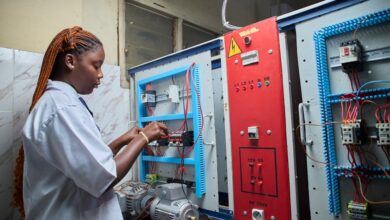AI Just Got Better at Counting Trees

AI Just Got Better at Counting Trees
Estimated Reading Time: 6 minutes
- Cutting-edge AI, specifically the TreeLearn method, is revolutionizing tree counting and segmentation for improved forest management.
- Accurate tree data is paramount for climate change mitigation (carbon sequestration), biodiversity management, and sustainable forestry.
- Achieving high accuracy requires diverse training data, allowing AI models to generalize across various forest types, resolutions, and data collection methods.
- Organizations can leverage this by investing in diverse data acquisition, prioritizing model fine-tuning, and fostering collaboration with researchers.
- This technology offers a scalable, robust, and efficient alternative to traditional, labor-intensive forest inventory methods.
- Key Takeaways
- The Crucial Need for Accurate Tree Counting
- Deep Learning: Revolutionizing Tree Segmentation
- Research Highlight: TreeLearn’s Enhanced Performance
- Actionable Steps for Leveraging AI in Forestry
- Real-World Example: Sustainable Timber Harvesting
- Conclusion
- Frequently Asked Questions (FAQ)
In the global effort to combat climate change, manage biodiversity, and ensure sustainable forestry, accurate data is paramount. One of the most fundamental pieces of information – how many trees are there, and where – has historically been a labor-intensive and often imprecise endeavor. However, the advent of artificial intelligence, particularly deep learning, is rapidly transforming this landscape. Recent advancements are pushing the boundaries of what’s possible, making AI an increasingly powerful and reliable tool for detailed forest analysis.
The ability to precisely count and segment individual trees from vast datasets collected by drones (UAVs) or ground-based laser scanners (LiDAR) is no longer a futuristic concept. It’s a present reality, and it’s getting significantly better, offering unprecedented detail and efficiency for foresters, researchers, and policymakers alike.
The Crucial Need for Accurate Tree Counting
Why does counting trees matter so much? From carbon sequestration to wildfire risk assessment, the implications are far-reaching. Forests are vital carbon sinks, absorbing vast amounts of CO2, and knowing their exact density and structure is critical for calculating their climate change mitigation potential. Accurate tree inventories also underpin sustainable logging practices, ensuring that resources are harvested responsibly without depleting natural assets.
Beyond commercial value, precise tree data helps in monitoring forest health, detecting disease outbreaks early, and understanding complex ecological systems. Traditional methods, often relying on manual surveys or less sophisticated aerial imagery, are prone to error, time-consuming, and expensive. This is where AI steps in, offering a scalable, robust, and increasingly accurate alternative.
Deep Learning: Revolutionizing Tree Segmentation
At the heart of this revolution is deep learning, a subset of AI that allows computer systems to learn from vast amounts of data. For tree counting, this means feeding algorithms enormous datasets of forest scans – known as point clouds – and teaching them to identify, delineate, and count individual trees. One such pioneering method is TreeLearn, a deep-learning-based tree segmentation technique that has recently demonstrated remarkable improvements in its ability to generalize across different types of forest data.
The challenge lies in the diversity of forest environments. A model trained on dense, coniferous forests might struggle with sparse, deciduous woodlands, or vice-versa. The latest research, however, shows that with strategic fine-tuning and diverse training data, AI models like TreeLearn can achieve exceptional accuracy, adapting to various “domains” (different forest types, data collection methods, and resolutions) with impressive results.
To fully appreciate the technical strides being made, let’s delve into the specific findings from recent research:
Research Highlight: TreeLearn’s Enhanced Performance
Table of Links Abstract and 1 Introduction Materials and Methods Results and Discussion Conclusion and References 3 RESULTS AND DISCUSSION Segmentation results were computed for the point cloud L1W (MLS, deciduous dominated). Results obtained by using the publicly available TreeLearn checkpoint without further training serve as a baseline (Table 3). Even when fine-tuning the model with out-of-domain data (UAV, coniferous dominated), instance segmentation performance in terms of the F1-score increases substantially from 93.98 % to 96.25 %. In terms of tree detection (one FP) and semantic segmentation (99.41%), the fine-tuned model performs slightly worse than the baseline. However, these aspects are less important compared to instance segmentation performance. For example, FP predictions can be manually discarded or merged into complete trees without much effort if they are not too frequent. When using in-domain data (MLS+TLS, deciduous dominated) for fine-tuning, instance segmentation performance is further increased to 97.31% (see Fig. 1 for a qualitative comparison). Since the number of trees used during training is roughly equal in the in-domain and out-of-domain conditions, the performance gap is most likely due to the domain-shift. However, other factors, such as differences in forest complexity, are hard to quantify and cannot be controlled for. When using all available data for training, test performance decreases slightly (96.88 %) compared to only using in-domain data. In addition to quantitative segmentation results on L1W, all three models were used to obtain qualitative results on RMIT, a low-resolution UAV point cloud (Fig. 2). These results suggest that an adequate segmentation performance on low-resolution UAV data can only be achieved when including it during training. If only MLS+TLS data is used, segmentation quality decreases drastically due to severe cases of merged trees. 4 CONCLUSION In this paper, we trained the deep-learning-based tree segmentation method TreeLearn with data from various domains and systematically evaluated its test performance. It was shown that a model trained on out-of-domain coniferous dominated UAV point clouds can generalize to deciduous dom inated MLS point clouds. Qualitative results indicate that training exclusively with high-resolution data, although improving performance in this domain, leads to poor generalization in low-resolution UAV settings (Fig. 2). Including UAV data in addition to high-resolution data during training alleviates this issue. This emphasizes the importance of a broad training data basis to obtain models that are applicable to a wide range of domains. To enrich the available forest point clouds, labeled tree data from previous works was propagated to the whole forest point cloud and is made publicly available at https://doi.org/10.25625/QUTUWU. Going forward, a quantifiable characterization of different forest point clouds should be established to enable a more thorough and systematic comparison between domains. Furthermore, the consequences of stronger domain-shifts in terms of forest structure on model performance should be investigated, for example by using dense tropical forests. Such experiments are crucial to determine what exactly is needed in terms of model development and data provision to obtain powerful and general tree segmentation models. The results of this study can be regarded as preliminary evidence for the potential of deep learning to obtain general tree segmentation methods. While such methods rely on high-quality labeled forest data, many recent works have acknowledged this need by providing publicly available datasets. Due to the rapid development of deep learning methods and the availability of more and more highquality labeled data, we expect deep-learning-based tree segmentation to become an increasingly powerful tool. In contrast to traditional segmentation methods, such methods are able to learn segmentation rules for forest point clouds with diverse characteristics in a data-driven way, thus eliminating the need for cumbersome hyperparameter tuning or models designed for specific domains. These features make methods user-friendly and practically applicable given highly diverse forest and point cloud characteristics. REFERENCES Andrew Burt, Mathias Disney, and Kim Calders. Extracting individual trees from lidar point clouds using treeseg. Methods Ecol. Evol., 10(3):438–445, 2019. doi: https://doi.org/10.1111/2041-210x.13121. Kim Calders, Hans Verbeeck, Andrew Burt, Niall Origo, Joanne Nightingale, Yadvinder Malhi, Phil Wilkes, Pasi Raumonen, Robert GH Bunce, and Mathias Disney. Laser scanning reveals potential underestimation of biomass carbon in temperate forest. Ecological Solutions and Evidence, 3(4): e12197, 2022. GreenValley International. Lidar360 point cloud post-processing software, 2022. URL https://greenvalleyintl.com/LiDAR360. Accessed: 26.10.2022. Jonathan Henrich, Jan van Delden, Dominik Seidel, Thomas Kneib, and Alexander Ecker. Treelearn: A comprehensive deep learning method for segmenting individual trees from forest point clouds. arXiv preprint arXiv:2309.08471, 2023. Li Jiang, Hengshuang Zhao, Shaoshuai Shi, Shu Liu, Chi-Wing Fu, and Jiaya Jia. Pointgroup: Dualset point grouping for 3d instance segmentation. In Proc. IEEE/CVF conf. comput. vis. Pattern recognit., pp. 4867–4876, 2020. doi: https://doi.org/10.1109/cvpr42600.2020.00492. Karel Kuzelka, Martin Slavık, and Peter Surovy. Very high density point clouds from uav laser ` scanning for automatic tree stem detection and direct diameter measurement. Remote Sensing, 12 (8):1236, 2020. Ilya Loshchilov and Frank Hutter. Sgdr: Stochastic gradient descent with warm restarts, 2016. Ilya Loshchilov and Frank Hutter. Decoupled weight decay regularization, 2017. Stefano Puliti, J Paul McLean, Nicolas Cattaneo, Carolin Fischer, and Rasmus Astrup. Tree height-growth trajectory estimation using uni-temporal uav laser scanning data and deep learning. Forestry, 96(1):37–48, 2023a. Stefano Puliti, Grant Pearse, Peter Surovy, Luke Wallace, Markus Hollaus, Maciej Wielgosz, and ` Rasmus Astrup. For-instance: a uav laser scanning benchmark dataset for semantic and instance segmentation of individual trees. arXiv prepr. arXiv:2309.01279, 2023b. doi: https://doi.org/10.1109/ccdc52312.2021.9602282. Charles R Qi, Or Litany, Kaiming He, and Leonidas J Guibas. Deep hough voting for 3d object detection in point clouds. In proc. IEEE/CVF Int. Conf. Comput. Vis., pp. 9277–9286, 2019. doi: https://doi.org/10.1109/iccv.2019.00937. Andreas Tockner, Christoph Gollob, Ralf Kraßnitzer, Tim Ritter, and Arne Nothdurft. Automatic tree crown segmentation using dense forest point clouds from personal laser scanning (pls). Int. J. Appl. Earth Obs. Geoinformation, 114:103025, 2022. doi: https://doi.org/10.1016/j.jag.2022.103025. Jan Trochta, Martin Krcek, Tomas Vrska, and Kamil Kral. 3D Forest: An application for descriptions of three-dimensional forest structures using terrestrial LiDAR. PloS one, 12(5):e0176871, 2017. doi: https://doi.org/10.1371/journal.pone.0176871. Thang Vu, Kookhoi Kim, Tung M Luu, Thanh Nguyen, and Chang D Yoo. Softgroup for 3d instance segmentation on point clouds. In Proc. IEEE/CVF Conf. Comput. Vis. Pattern Recognit., pp. 2708–2717, 2022. doi: https://doi.org/10.1109/cvpr52688.2022.00273. Martin Wieser, Gottfried Mandlburger, Markus Hollaus, Johannes Otepka, Philipp Glira, and Norbert Pfeifer. A case study of uas borne laser scanning for measurement of tree stem diameter. Remote Sensing, 9(11):1154, 2017. B Xiang, T Peters, T Kontogianni, F Vetterli, S Puliti, R Astrup, and K Schindler. Towards accurate instance segmentation in large-scale lidar point clouds. ISPRS Annals of the Photogrammetry, Remote Sensing and Spatial Information Sciences, 10:605–612, 2023. doi: https://doi.org/10.5194/isprs-annals-X-1-W1-2023-605-2023.
Authors:
(1) Jonathan Henrich, Chairs of Statistics and Econometrics, Faculty of Economics, University of Gottingen, Germany (jonathan.henrich@uni-goettingen.de)
(2) Jan van Delden, Institute of Computer Science, University of Gottingen Germany (jan.vandelden@uni-goettingen.de).
This paper is available on arxiv under CC by-SA 4.0 Deed (Attribution-Sharealike 4.0 International) license.
The findings are clear: AI models, when properly trained and fine-tuned with diverse data, can achieve remarkable instance segmentation performance. The ability to increase the F1-score from 93.98% to 96.25% with out-of-domain data, and further to 97.31% with in-domain data, highlights the precision now attainable. This translates into highly accurate individual tree identification, a critical step for detailed forest analysis.
This study underscores the importance of a broad training data basis. Models trained solely on high-resolution data performed poorly when applied to low-resolution UAV data. This means that to create truly general and applicable AI models, they must be exposed to a wide variety of forest types, resolutions, and data acquisition methods during their training phase.
Actionable Steps for Leveraging AI in Forestry
- Invest in Diverse Data Acquisition: Recognize that the quality and diversity of training data are paramount. Incorporate various data sources like Mobile Laser Scanning (MLS), Terrestrial Laser Scanning (TLS), and Unmanned Aerial Vehicle (UAV) LiDAR, covering different forest types (coniferous, deciduous) and resolutions. The publicly available labeled tree data from works like those cited offers a valuable starting point.
- Prioritize Model Fine-Tuning and Generalization: Don’t settle for off-the-shelf models for critical applications. Actively fine-tune deep learning models using localized or specific domain data to optimize performance for your particular forest characteristics. Emphasize models capable of strong generalization across different scales and complexities.
- Foster Collaboration and Knowledge Sharing: Engage with academic institutions and technology developers leading in AI and remote sensing. Contribute to and utilize publicly available datasets, such as the one highlighted in the research (https://doi.org/10.25625/QUTUWU), to accelerate the development of more powerful and general tree segmentation models.
Real-World Example: Sustainable Timber Harvesting
Imagine a timber company operating across a vast, mixed-species forest. By deploying AI-driven tree counting and segmentation, they can receive precise inventories of marketable trees, identify areas for selective logging without harming protected species or vulnerable ecosystems, and accurately estimate timber volume. This eliminates wasteful manual surveys, reduces operational costs, and, crucially, ensures that harvesting practices are genuinely sustainable, contributing to long-term forest health and carbon sequestration goals.
Conclusion
The advancements in AI-driven tree counting and segmentation represent a significant leap forward in our ability to understand, manage, and protect our planet’s forests. By leveraging deep learning methods like TreeLearn, combined with strategic data acquisition and fine-tuning, we can move beyond cumbersome traditional methods to adopt user-friendly, data-driven approaches. These innovations are not just about counting trees; they are about fostering more sustainable ecosystems, enhancing climate action, and making informed decisions that benefit both nature and human society.
As the technology continues to evolve and more high-quality data becomes available, the potential for AI in forestry is boundless. It’s an exciting time for environmental science and technology, promising a future where our forests are managed with unparalleled precision and insight.
Explore the Publicly Available Tree Data
Frequently Asked Questions (FAQ)
What is TreeLearn and how does it improve tree counting?
TreeLearn is a deep-learning-based tree segmentation method that uses AI to identify, delineate, and count individual trees from vast datasets like LiDAR point clouds. It significantly improves accuracy over traditional methods, especially when fine-tuned with diverse data, leading to more precise forest inventories.
Why is having diverse training data crucial for AI in tree counting?
Diverse training data, encompassing various forest types (coniferous, deciduous), data collection methods (UAV, MLS, TLS), and resolutions, is crucial for AI models like TreeLearn to generalize effectively. Without it, a model trained on one type of forest might perform poorly in another, leading to inaccuracies. Broad data exposure ensures the AI can adapt to different “domains” and maintain high performance.
How does accurate tree counting contribute to combating climate change?
Forests are critical carbon sinks, absorbing CO2 from the atmosphere. Accurate tree counting and segmentation provide precise data on forest density and structure, allowing for better calculation of carbon sequestration potential. This information is vital for climate change mitigation strategies, sustainable forest management, and effective carbon credit programs.
What are the practical benefits for organizations adopting AI-driven tree segmentation?
Organizations, such as timber companies or environmental agencies, benefit from increased efficiency and reduced costs by replacing labor-intensive manual surveys. AI provides highly accurate inventories for sustainable logging, early detection of disease, and better assessment of forest health. This leads to more informed decision-making, improved resource management, and stronger ecological protection.





